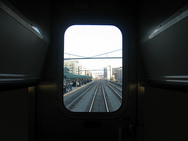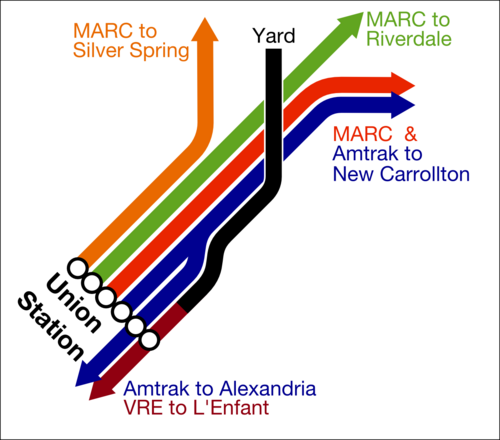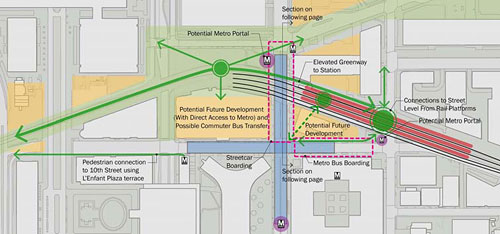Through-running isn’t so easy for MARC and VRE, part 2

Photo by tracktwentynine on Flickr.
If MARC trains at Union Station became VRE trains to Virginia and vice versa, riders could reach more stations and we could use Union Station’s limited tracks more efficiently. Unfortunately, there are several reasons this isn’t as easy as it sounds. That doesn’t mean trains can’t run through, but a number of changes have to happen first, which cost money.
Previously, we talked about the biggest obstacle, high and low platforms. MARC has some high platforms and some low platforms, and wants one car type that can serve both, across all lines. But using those cars on VRE would slow down boarding considerably.
Still, is that a deal-breaker? The Brunswick Line has all low platforms today, which could accommodate VRE trains. What about just running VRE trains onto the Brunswick Line and vice versa to start with? Or just have some MARC trains go at least to Alexandria?
Unfortunately, the track layout at Union Station, insufficient space for reverse-direction trains on most lines, and limited platforms at L’Enfant and Crystal City all pose obstacles.
Union Station’s tracks don’t line up VRE and the Brunswick MARC
At Union Station, VRE trains coming from the south enter the station from the First Street Tunnel, at the far eastern end of the station. But the Brunswick Line’s tracks come into the station at its far western end.
A Brunswick train crossing from the CSX Metropolitan Subdivision tracks on the west side of the station to the through tracks on the east side would have to cross all the tracks at Union Station, blocking trains on the other MARC, Amtrak and VRE lines.
That doesn’t mean crossing over is impossible. It just makes scheduling more difficult. If in the future, for example, Acelas leave (and arrive) every 30 minutes and Regionals leave/arrive every 30 minutes, and MARC Penn trains leave and arrive every 20, there aren’t many gaps for trains to cross over, and doing so can cause delays.
The Penn Line trains wouldn’t face this problem, and as the highest-ridership line, that is the most logical one for through-running. But this is also the line with the most high platforms and thus the greatest incompatibility between MARC and VRE.
There isn’t enough reverse-direction capacity
The Penn Line tracks do line up with the First Street tunnel; that’s what Amtrak trains use to get to Virginia. Those trains could continue south to Alexandria, or even farther south. This could be a great asset for Penn Line riders, who could stay on the train to L’Enfant Plaza if they want the Metro Orange, Blue, Yellow or Green Lines, or ride to Crystal City or Alexandria if they work at jobs in Virginia.
Unfortunately, this would run into a second problem. There isn’t enough track capacity south of Union Station. Right now, there are 2 tracks across the Potomac on the Long Bridge, and 3 through the L’Enfant Plaza area. CSX controls these tracks, and doesn’t let VRE use all of the tracks.
Right now, VRE trains run almost entirely one-way. The trains head into DC on one track in the morning, and back out to Virginia on one track in the afternoon; in between, the trains sit at a yard near Ivy City in DC. The VRE schedule lists just one reverse-direction train, on the Manassas Line each morning and evening. Amtrak’s trains go both ways all day, but there are only a few of those and mainly not at rush hours.
The bottom line is, if Virginia and Maryland wanted to have all or even some Penn Line trains continue past Union Station at least to Alexandria, there wouldn’t be enough track space.
A similar problem applies to letting VRE trains continue north of Union Station. CSX has resisted letting Maryland’s MTA add more MARC trains on the Brunswick and Camden Lines without also demanding Maryland invest some money into improvements along the route.
Stations are limited
Another issue with through-running is the design of the VRE stations at L’Enfant and Crystal City. These stations each have just one platform on one side of the tracks. That means trains can only serve the stations in one direction at a time.
This means the reverse peak direction trains on the Manassas Line each morning and afternoon can’t stop at Crystal City or L’Enfant, because the trains running in the peak direction are using the platform track.
If Brunswick (or other MARC) trains could run south of Union Station today, they couldn’t stop at L’Enfant or Crystal City, which is where most of the MARC riders would likely want to go.
Most of the other stops on the Manassas Line have the same configuration, with platforms only on one side as well. This will prove to be an obstacle for additional reverse peak direction trains, whether they’re MARC or VRE.
Maryland Ave plan and Long Bridge study could fix this
There is hope on the horizon. The recent Maryland Avenue study recommended building a fourth track at L’Enfant Plaza. CSX could then let passenger trains travel in both directions at high frequency in that area. It would also transform the station from just one platform to 3, with a combination of high and low platforms for both types of trains.
The next bottleneck would be the 2-track Long Bridge across the Potomac, and there’s another study going on for that. VRE’s 2004 strategic plan recommended adding a 3rd track from the Long Bridge to Crystal City, where the line widens to 3 tracks, and giving the Crystal City station an island platform to serve trains in both directions.
Combined with needed improvements at Union Station, we might one day see a truly regional rail system, at least from Baltimore and maybe Frederick to Alexandria, alongside more frequent service from Fredericksburg and Manassas to DC. To make this happen, however, Maryland and Virginia will have to make it a priority. With an 8-year-old VRE plan and a 5-year-old MARC plan mostly collecting dust, riders will need to push their leaders to put resources into commuter rail.


